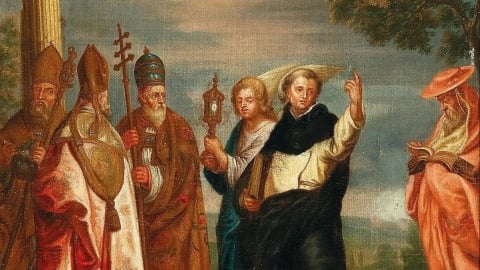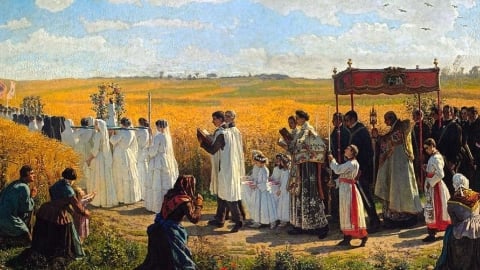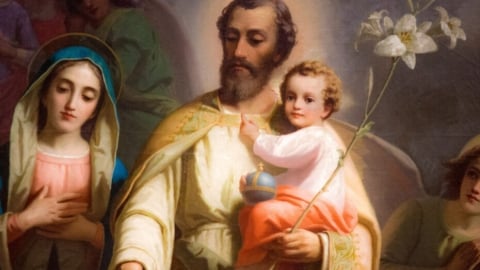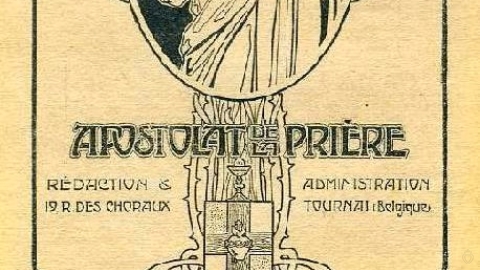The Month of May dedicated to Mary

Devotion to our Blessed Lady, the gracious and radiant Queen of the Universe, is essentially something sweet and joyful. There is absent from Mary's countenance that sternness which becomes the face of the supreme Lord and Judge. All about her breathes confidence and love. In her we venerate the very masterpiece of divine wisdom and love. She is all fair and in her there is no stain, and she stands before us in all the radiant beauty of a perfect nature illumined and transfigured by the glory of an inconceivable supernatural holiness. With the Catholic Church we may apply to her the praises bestowed in the first instance upon Eternal Wisdom, in whom alone they are fully and literally realized. Yes, Mary is as "a vapor of the power of God and a certain pure emanation of the glory of the Almighty God: and therefore, no defiled thing cometh into her, for she is the brightness of eternal light and the unspotted mirror of God's Majesty" (Wisdom, vii. 25, 26).
Seeing that she is all fair and unspeakably beautiful, what could be more appropriate than to dedicate to her the fairest of all the months of the year? Devotion to Mary is as old as the Church, even though its manifestation has greatly varied according to time and place. One could scarcely expect a father of the fourth century to write as did St. Bernard or St. Anselm. St. Alphonsus' popular books and sermons display an exuberance which may not- in fact, which does not-appeal to people of the sterner North, even though they do not in any way lag behind the Neapolitan's love for the Madonna.
In the first centuries of our era, our Blessed Lady's position in the divine economy was indeed clearly stated, but the insistence was rather on her divine maternity-that is, the virgin birth and her virginity before, during and after the birth of Christ-than on the many practical and devotional consequences that follow from that fundamental fact. During the first three centuries it was perhaps necessary not to put Mary in the foreground lest the pagans should look upon her and her motherhood as only yet another of the many mythological and too often scandalous stories with which their poets had familiarized them. But the earliest ecclesiastical writers make her unique position quite clear. Nothing that has been written later on surpasses the eloquence and enthusiastic love breathed forth by the sermons and treatises of the Fathers and Doctors of the era of the great Christological controversies. It is, perhaps, not too much to say that it was above all else the Council of Ephesus, in 431, that gave the greatest impetus to devotion to Mary, just as the Council itself and the City of Ephesus witnessed the greatest triumph of the Queen of Heaven when the Fathers condemned the heresy of Nestorius and solemnly and for all time formulated the glorious doctrine of the mystery of the Incarnation, at the same time as they triumphantly established her unique status as Mother of the Son of God. From that time onwards Mary went, so to speak, from triumph to triumph, and before many centuries had gone by her sweet festivals, like so many stars, studded the heaven of the Church's Liturgy.
The very popularity of Marian devotion and its manifold forms make it extremely difficult to discover a beginning. Perhaps, the great Swabian mystic, Blessed Henry Suso, marks such a time. It was his custom on the first day of May-when young men carried a verdant and flowering branch through the streets, which they called the May, singing songs all the while-to choose for his own may the holy Cross, inasmuch as it seemed to him that neither fields nor forests had yielded a tree more beautiful or richer in leaf and flower and fruit. The reader of Blessed Henry's Life is almost sickened by the appalling austerities and tortures that the Servant of God inflicted on his poor body. Yet, this amazing ascetic had the tenderness of heart of a child and the imagination of a poet. Thus, even in his childhood he never picked a spring flower unless he had first offered some to the Blessed Virgin, and even after he 'had become a preaching Friar and entered upon his career of penance, he still "picked flowers with many loving thoughts, and carrying them to his cell made a garland of them… Once, at the beginning of May, he had, according to his custom, placed with great devotion a garland of roses upon his loveliest heavenly Lady... And when the time had come for him to greet her as he was wont to do, ... it seemed to him as if he were in the midst of a heavenly choir and that they were singing the Magnificat in praise of God's Mother". This takes us back as far as the first decades of the fourteenth century. If there is here no question of a Month of Mary as we know it, Henry Suso nevertheless marks a beginning. Fr. Thurston, S.J., in a well-documented paper in The Month of May, 1901, states that the first printed "Month of Mary" appears to have been a little book by a certain Father Annibale Dionisi, about the beginning of the eighteenth century. Earlier than this Fr. Nadasi, S.J., published a book of devotions to Mary distributed over a whole month, but it is uncertain whether they were intended for use during May more than at any other period of the year. May devotions as now practiced seem, therefore, to date from the eighteenth century. In the Preface to his book Fr. Dionisi indicates the chief reason for dedicating May to Our Lady:
"Since the devout clients of Mary are accustomed to venerate her at three different times each day (viz., in the morning, at midday and in the evening), and also on one special day in each week (viz., the Saturday), it appears only reasonable to dedicate to her one entire month in every year. And since in making an offering, we ought to give of our best, so from amongst all months that one is chosen which is the most beautiful in the year, viz., May, the season of flowers, which invites us to crown her with the flowers of virtuous actions" (cf. The Month, May, 1901, pp. 481, 482).
"A man may say: "True, but in this climate we have sometimes a bleak, inclement May.' This cannot be denied; but still so much is true that at least it is the month of promise and of hope. . .
May, thus, is the month, if not of fulfillment, at least of promise, and is not this the very aspect in which we most suitably regard the Blessed Virgin?" (Newman, "Devotions," p. 3.)
Although May devotions, as such, are of recent origin when compared to the Sacred Liturgy and always belong to the realm of private piety, they have now become so popular and so well-established that a church where these exercises are not held can hardly fail to create a certain unenviable admiratio.
In a large parish, where there are several priests, it should be possible to have the presence of one of them each day, and if a daily ferverino is thought to be too much, at least a reading from some solid book will make of May a miniature parish retreat. Hence the opportunity for doing good is great. Nor need the little addresses be explicitly and exclusively on Our Lady. It will make the exercises easier, more interesting and more fruitful if the priest gives a series of simple talks on the virtues and practices of a devout life-on prayer, holy reading, works of charity, etc., in all of which Mary is not only an inspiration but an actual and eminently practical example.
Benediction, at least with the Ciborium, would be a most fitting conclusion of the prayers, instruction and hymns of each day, and in this way, Mary would still be carrying out her providential and most glorious mission of leading men to her divine Son: Ad Jesum per Mariam.





